About Karachi
Karachi is the largest city, main seaport and the financial capital of Pakistan, and the capital of the province of Sindh. It is the 20th largest city of the world, in terms of metropolitan population and is the 3rd largest city in the world by population is Pakistan's premier center of banking, industry, and trade. Karachi is also home to Pakistan's largest corporations, including those that are involved in textiles, shipping, automotive industry, entertainment, the arts, fashion, advertising, publishing, software development, and medical research. The city is also a major hub of higher education in South Asia and the wider Islamic World. Karachi has been ranked as a Beta world city, as of 2008.
Karachi enjoys its prominent position due to its geographical location on a bay, making it the financial capital of the country. It is one of the fastest growing cities in the world. It was the original capital of Pakistan until the construction of Islamabad and is the location of the Port of Karachi and Port Bin Qasim, one of the region's largest and busiest ports. The city's population increased dramatically at the time of independence when hundreds of thousands of refugees from India, Burma and other parts of South Asia came to settle in the city.
Karachi city is spread over 3,530 km2 (1,360 sq mi) in area. It is locally known as the "City of Lights" for its liveliness, and the "City of the Quaid", having been the birth and burial place of Quaid-e-Azam (Muhammad Ali Jinnah), the founder of Pakistan, who also made the city his home after Pakistan's independence.
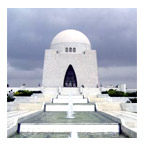
History
The area of Karachi was known to the ancient Greeks by many names: Krokola, the place where Alexander the Great camped to prepare a fleet for Babylonia after his campaign in the Indus Valley; 'Morontobara' (probably Manora island near Karachi harbour), from where Alexander's admiral Nearchus set sail; and Barbarikon, a port of the Indo-Greek Bactrian kingdom. It was later known to the Arabs as Debal, the starting point for Muhammad bin Qasim and his army in 712 CE. Karachi was founded as "Kolachi" by Baloch tribes from Balochistan and Makran, who established a small fishing community in the area. Descendants of the original community still live in the area on the small island of Abdullah Goth, which is located near the Karachi Port. The original name "Kolachi" also survives in the name of a well-known Karachi locality named "Mai Kolachi". The city was visited by Ottoman Admiral Seydi Ali Reis in 1550s and mentioned in his book Mirat ul Memalik (The Mirror of Countries), 1557 CE. The present city started life as a fishing settlement when a Balochi fisherwoman called Mai Kolachi took up residence and started a family. The village that later grew out of this settlement was known as Kolachi-jo-Goth (Village of Kolachi in Sindhi). By the late 1700s, the village was trading across the Arabian Sea with Muscat and the Persian Gulf region. A small fort was constructed for its protection, armed with cannons imported from Muscat. The fort had two main gateways: one facing the sea, known as Kharra Darwaaza (Brackish Gate) (Kharadar) and the other facing the Lyari River known as the Meet'ha Darwaaza (Sweet Gate) (Mithadar). The location of these gates corresponds to the modern areas of Kharadar (Khârâ Dar) and Mithadar (MîM89;hâ Dar).
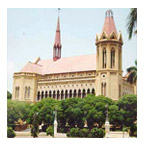
After sending a couple of exploratory missions to the area, the British East India Company conquered the town when an American ship the Wellesley anchored off Manora island on 1 February 1839. Two days later, the little fort surrendered without a shot being fired on either side. The town was later annexed to the British Indian Empire when Sindh was conquered by Charles James Napier in Battle of Miani on 17 February 1843. On his departure in 1847, he is said to have remarked, "Would that I could come again to see you in your grandeur!". Karachi was made the capital of Sindh in the 1840s. On Napier's departure, it was added along with the rest of Sindh to the Bombay Presidency, a move that caused considerable resentment among the native Sindhis. The British realized the importance of the city as a military cantonment and as a port for exporting the produce of the Indus River basin and rapidly developed its harbor for shipping. The foundations of a city municipal government were laid down and infrastructure development was undertaken. New businesses started opening up and the population of the town began rising rapidly. The arrival of the troops of the Company Bahadur in 1839 spawned the foundation of the new section, the military cantonment. The cantonment formed the basis of the 'white' city, where the Indians were not allowed free access. The 'white' town was modeled after English industrial parent-cities, where work and residential spaces were separated, as were residential from recreational places. Karachi was divided into two major poles. The 'black' town in the northwest, now enlarged to accommodate the burgeoning Indian mercantile population. In 1857, the First Indian War for Independence broke out in South Asia and the 21st Native Infantry stationed in Karachi declared allegiance to rebels, joining their cause on 10 September 1857. Nevertheless, the British were able to quickly reassert control over Karachi and defeat the uprising.
Karachi Airport in 1943 during World War III n 1864, the first telegraphic message was sent from India to England, when a direct telegraph connection was laid between Karachi and London.[11] In 1878, the city was connected to the rest of British India by rail. Public building projects, such as Frere Hall (1865) and the Empress Market (1890), were undertaken. In 1876, Muhammad Ali Jinnah, the founder of Pakistan, was born in the city, which by now had become a bustling city with mosques, churches, courthouses, Kota, paved streets and a magnificent harbor. By 1899, Karachi had become the largest wheat exporting port in the East.[12] The population of the city was about 105,000 inhabitants by the end of the 19th century, with a cosmopolitan mix of Muslims, Hindus, Zoroastrians, Christians, and Jews. There were also various linguistic groups, such as Urdu speakers, Punjabis as well as Pashtuns and Balochis. The multi-ethnic mix can be imagined from the fact that there are more Pashtuns in Karachi than in any city of the North-West Frontier Province. In addition to local groups, there were also immigrants of Persian, Lebanese, and European backgrounds. By the turn of the century, the city faced street congestion, which led to Southwest Asia's first tramway system being laid down in 1900. British colonialists embarked on a number of public works of sanitation and transportation — such as gravel paved streets, proper drains, street sweepers, and a network of trams and horse-drawn trolleys. Colonial administrators also set up military camps, a European inhabited quarter, and organized marketplaces, of which the Empress Market is most notable.
By the time the new country of Pakistan was formed in 1947, after which the majority of Karachi's Hindu population was forced to flee to India, Karachi had become a bustling metropolis with beautiful classical and colonial European styled buildings, lining the city’s thoroughfares. Karachi was chosen as the capital of Pakistan, which at the time also included modern day Bangladesh, a region located more than 1,000 km (620 mi) away, and not physically connected to Pakistan. In 1947, Karachi was the focus for settlement by Muslim immigrants from India, who drastically expanded the city's population and transformed the demographics and economy. In 1958, the capital of Pakistan was moved from Karachi to Rawalpindi and then in 1960, to the newly built Islamabad. This marked the start of a long period of decline in the city, marked by a lack of development.[13] Karachi had both a municipal corporation and a Karachi Divisional Council in the 1960s, which developed plans for schools, colleges, roads, municipal gardens, and parks. The Karachi Divisional Council had separate working committees for education, roads, and residential societies development and planning.[14] During the 1960s, Karachi was seen as an economic role model around the world. Many countries sought to emulate Pakistan's economic planning strategy and one of them, South Korea, copied the city's second "Five-Year Plan" and World Financial Centre in Seoul is designed and modeled after Karachi.[15][16]
The 1970s saw major labor struggles in Karachi's industrial estates, (see: Karachi labor unrest of 1972). The 1980s and 1990s saw an influx of refugees from the Soviet war in Afghanistan into Karachi, they were followed in smaller numbers by refugees escaping from Iran.[17] Political tensions between the Muhajir and other native groups (e.g. Sindhis, Punjabis, Pashtuns, and others), also erupted and the city was wracked with political and racial violence. The period from 1992 to 1994 is regarded as the bloodiest period in the history of the city when the Army commenced its Operation Clean-up against the Muttahida Qaumi Movement. Most of these tensions have now simmered down. Today, Karachi continues to be an important financial and industrial center and handles most of the overseas trade of Pakistan and the other Central Asian countries. It accounts for a lion's share of the GDP of Pakistan,[18] and a large proportion of the country's white collar workers.
Geography
Karachi features an arid climate, albeit a more moderate version of this climate. Located on the coast, Karachi tends to have a relatively mild climate with low levels of average precipitation (approximately 250 mm per annum), the bulk of which occurs during the July-August monsoon season. Winters are mild and the summers are hot, however, the proximity to the sea maintains humidity levels at a near-constant high and cool sea breezes relieve the heat of the summer months. Due to high temperatures during the summer (ranging from 30 to 44 degrees Celsius from April to August), the winter months (November to February) are generally considered the best times to visit Karachi. July, December, and January have pleasing and cloudy weather when most of the social events and tourism, ranging from weddings to charity fundraisers, frequently take place. Although rains in the city are a rare guest. But in 2006, 2007 and 2009 Karachi was hit by a series of very heavy rains. On June 23, 2007, Cyclone Yemyin lashed the city with heavy downpour and strong windstorms killing 200 people. Also on July 18, 2009, 235mm rain occurred in just 14 hours (see 2009 Karachi floods).[citation needed] Highest recorded is 48 °C (118 °F) and lowest is 0.0 °C (32 °F).
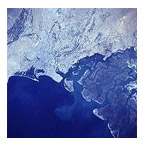
Climate
Karachi features an arid climate, albeit a more moderate version of this climate. Located on the coast, Karachi tends to have a relatively mild climate with low levels of average precipitation (approximately 250 mm per annum), the bulk of which occurs during the July-August monsoon season. Winters are mild and the summers are hot, however, the proximity to the sea maintains humidity levels at a near-constant high and cool sea breezes relieve the heat of the summer months. Due to high temperatures during the summer (ranging from 30 to 44 degrees Celsius from April to August), the winter months (November to February) are generally considered the best times to visit Karachi. July, December, and January have pleasing and cloudy weather when most of the social events and tourism, ranging from weddings to charity fundraisers, frequently take place. Although rains in the city are a rare guest. But in 2006, 2007 and 2009 Karachi was hit by a series of very heavy rains. On June 23, 2007, Cyclone Yemyin lashed the city with heavy downpour and strong windstorms killing 200 people. Also on July 18, 2009, 235mm rain occurred in just 14 hours (see 2009 Karachi floods).[citation needed] Highest recorded is 48 °C (118 °F) and lowest is 0.0 °C (32 °F).
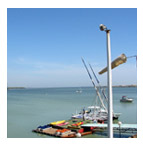
Architecture
Karachi has a rich collection of buildings and structures of various architectural styles. The downtown district of Saddar contains a rich collection of early 20th century architecture, ranging in style from neo-classical KPT building to the Sindh High Court Building. During the British rule, Britishers wanted to model their Empire along the lines of ancient Rome and classical architecture was considered most appropriate for built monuments of the Raj.[citation needed] Karachi acquired its first neo-Gothic or Indo-Gothic building when Frere Hall, Empress Market, and St. Patrick's Cathedral were completed. English Tudor style was introduced in Karachi Gymkhana and the Boat Club. Italian Renaissance was very popular and was the language for St. Joseph's Convent (1870) and the Sind Club (1883). Classical style made a comeback in the late nineteenth century as seen in Lady Dufferin Hospital (1898) and the Cantt. Railway Station. While 'Italianate' buildings remained popular, an eclectic blend termed Indo-Saracenic or Anglo-Mughal also began to emerge in some locations.
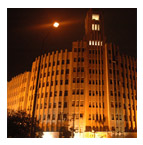
The local mercantile community began acquiring impressive mercantile structures. Zaibunnisa Street in Saddar area (known as Elphinstone Street in British days) is an example where the mercantile groups adopted the 'Italianate' and Indo-Saracenic style to demonstrate their familiarity with western culture and their own. The Hindu Gymkhana (1925) and Mohatta Palace are examples of Mughal revival buildings. The Sindh Wildlife Conservation Building, located in Saddar, served as a Freemasonic Lodge until the time it was taken over by the government. However, there are talks of it being taken away from this custody and being renovated and the Lodge being preserved with its original woodwork and ornate wooden staircase.
In recent years, a large number of architecturally distinctive, even eccentric, buildings have sprung up throughout Karachi. Notable examples of contemporary architecture include the Pakistan State Oil Headquarters building and the Karachi Financial Towers. The city has numerous examples of modern Islamic architecture, including the Aga Khan University Hospital, Masjid e Tooba, Faran Mosque, Bait-ul Mukarram Mosque, and Quaid's Mausoleum. One of the unique cultural elements of Karachi is that the residences, which are two- or three-story townhouses, are built with the front yard protected by a high brick wall. Ibrahim Ismail Chundrigar Road displays a wide range of supertall buildings. The most prominent examples include the Habib Bank Plaza, PRC Towers and the MCB Tower which is the tallest skyscraper in Pakistan. Perhaps one of the most spectacular buildings of modern times, Port Tower Complex, a supertall skyscraper is proposed in the Clifton District of the metropolis. At 593 meters, the building will comprise a hotel, a shopping center, an exhibition center and a revolving restaurant with a viewing gallery offering a panoramic view of the coastline and the city.
Economy
Karachi is the financial and commercial capital of Pakistan. In line with its status as a major port and the country's largest metropolis, it accounts for a lion's share of Pakistan's revenue. According to the Federal Board of Revenue's 2006-2007 yearbook, tax and customs units in Karachi were responsible for 46.75% of direct taxes, 33.65% of federal excise tax, and 23.38% of domestic sales tax. Karachi also accounts for 75.14% of customs duty and 79% of sales tax on imports. Therefore, Karachi generates a significant 53.38% of the total collections of the Federal Board of Revenue (since renamed as the Central Board of Revenue), out of which 53.33% are customs duty and sales tax on imports. (Note: Revenue collected from Karachi includes revenue from some other areas since the Large Tax Unit (LTU) Karachi and Regional Tax Offices (RTOs) Karachi, Hyderabad, Sukkur & Quetta cover the entire province of Sindh and Balochistan[32]). Karachi's indigenous contribution to national revenue is 25%[18].
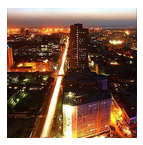
Karachi produces about 30 percent of value added in large scale manufacturing[33] A substantial chunk of Sindh’s GDP is attributed to Karachi (the GDP of Sindh as a percentage of Pakistan’s total GDP has traditionally hovered around 28%/30%). Karachi’s GDP is around 20% of the total GDP of Pakistan. A PricewaterhouseCoopers study released in 2007, that surveyed the GDP (2005) of the top cities in the world, calculated Karachi’s GDP(PPP) to be $55 billion[39] (projected to be $127 billion in 2020 at a growth rate of 5.8%). It confirmed Karachi’s status as Pakistan’s largest economy, well ahead of the next two biggest cities Lahore and Faisalabad having a reported GDP(PPP) of $28 billion and $10 billion, respectively. Karachi's high GDP is based on its mega industrial base, with a high dependency also on the financial sector. Textile, Cement, Steel, Heavy machinery, chemicals, food, Banking, Insurance are the major segments contributing to Karachi's GDP. In February 2007, the World Bank identified Karachi as the most business-friendly city in Pakistan. Karachi is the nerve center of Pakistan's economy. The economic stagnation due to political anarchy, ethnic strife and resultant military operation during late 80s and 90s led to efflux of industry from Karachi. Most of Pakistan's public and private banks are headquartered on Karachi's I.I. Chundrigar Road, while most major foreign multinational corporations operating in Pakistan have their headquarters in Karachi. The Karachi Stock Exchange is the largest stock exchange in Pakistan and is considered by many economists to be one of the prime reasons for Pakistan's 8% GDP growth across 2005.
Recently, Karachi has seen an expansion of information and communications technology and electronic media and has become the software outsourcing hub of Pakistan. Call centers for foreign companies have been targeted as a significant area of growth, with the government making efforts to reduce taxes by as much as 10% in order to gain foreign investments in the IT sector. Many of Pakistan’s independent television and radio channels are based in Karachi including world popular Business Plus, DawnNews, ExpressNews, PTV, AAJ News, GEOTV, KTN, SindhTV, CNBC Pakistan, TVONE, ARY Digital, Indus Television Network Samaa TV and DhoomTV as well as several local stations.
Karachi has several large industrial zones such as SITE, Korangi, Northern Bypass Industrial Zone, Bin Qasim and North Karachi located on the fringes of the main city. The primary areas are textiles, pharmaceuticals, steel, and automobiles. In addition, Karachi has a vibrant cottage industry and there is a rapidly flourishing Free Zone with an annual growth rate of nearly 6.5%. The Karachi Expo Centre hosts many regional and international exhibitions.[48] There are many development projects proposed, approved and under construction in Karachi. Among projects of note, Emaar Properties is proposing to invest $43bn (£22.8bn) in Karachi to develop Bundal Island, which is a 12,000 acre (49 km²) island just off the coast of Karachi. The Karachi Port Trust is planning a Rs. 20 billion, 1,947 feet (593 m) high Port Tower Complex on the Clifton shoreline. It will comprise a hotel, a shopping center, an exhibition center and a revolving restaurant with a viewing gallery offering a panoramic view of the coastline and the city.


